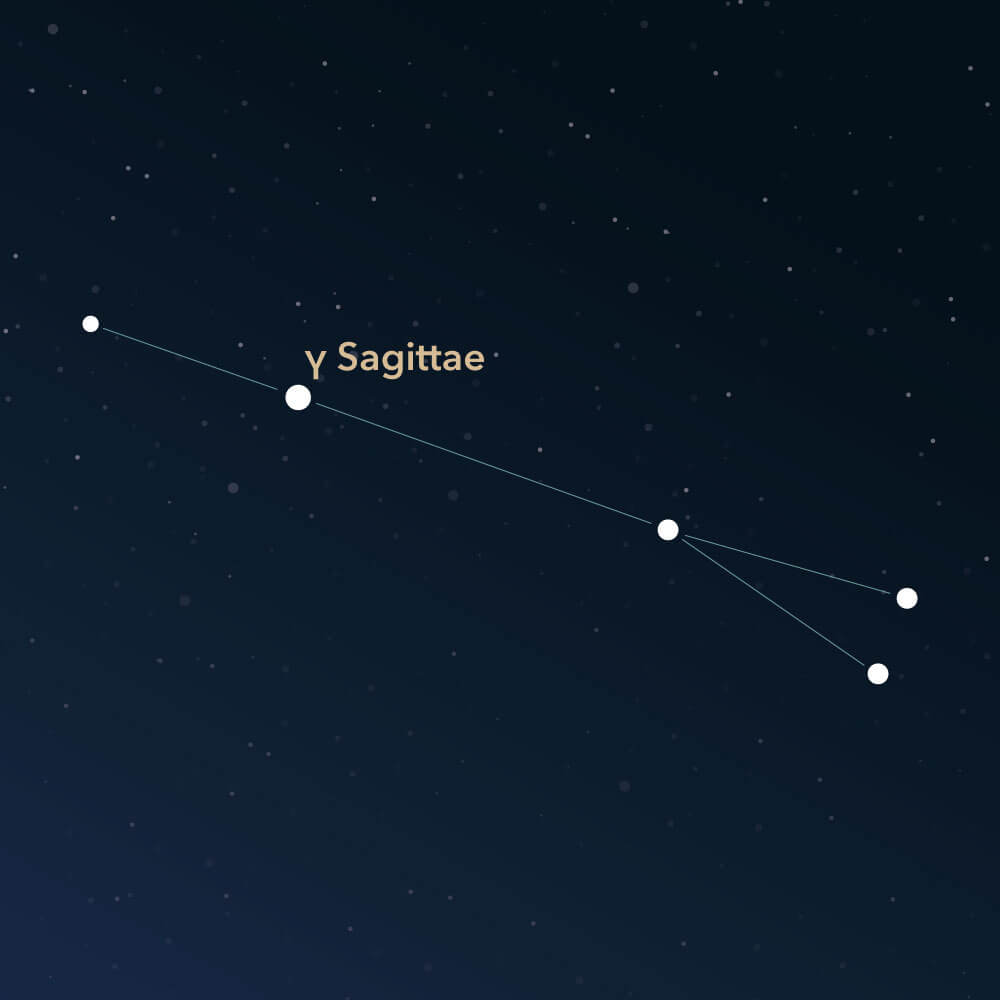The constellation Sagitta
Caratteristiche
- Nome latino
- Sagitta
- Emisfero
- Emisfero settentrionale
- Visibilità
- June - September
- Area
- 80 deg²
- Stella più luminosa
- γ Sagittae (HIP number 98337)
- Specialità
- Globular cluster, planetary nebulae, emission nebula

The Sagitta, Latin for Arrow, is a small and inconspicuous constellation in the northern sky. It is a classical constellation of antiquity that was described by the Roman-Greek astronomer Claudius Ptolemy. In its area is a unique deep-sky object.
Hemisphere, visibility, and area
The constellation Sagitta lies in the northern celestial sky and can be observed from many locations. It is visible from all places in the northern hemisphere, and it appears completely in the night sky up to the 69th latitude south of the equator. It can only not be seen from the Antarctic.
The best time to observe it is from June to September, with August being the best month. Sagitta has an area of only about 80 square degrees, making it the third smallest constellation in the entire sky.
In star charts, the constellation is visualized with its main stars, which form a recognizable arrow. The brightest star is γ Sagittae (Gamma Sagittae). It has an apparent magnitude of only about 3.5 and is located approximately 260 light-years away from earth.
The other stars are even dimmer, making it challenging to locate the Sagitta in the night sky. Therefore, it can be helpful to use other nearby constellations as reference points. The four constellations adjacent to Sagitta are Vulpecula, Hercules, Aquila, and Delphinus.
Specialties in the constellation
In the area of the Sagitta, there are several planetary nebulae, as well as a globular cluster and an emission nebula.
Especially interesting is the emission nebula M1-67, as it is a Wolf-Rayet ring nebula, which means it is the exposed core of a former massive star. The apparent magnitude of the star is around 11.2 mag, and its distance from earth is estimated to be more than 10,000 light-years. Due to its exceptionally strong stellar wind, the outer shell is being pushed away from the star at high speed, creating a circumstellar nebula.
The planetary nebulae are not particularly bright and, therefore, cannot be seen with the naked eye.
The globular cluster M71 (Messier 71) or NGC 6838 is slightly brighter but only visible with professional equipment, such as telescopes or binoculars. Its apparent magnitude is about 8.4 mag, and it is estimated to be 13,000 light-years away.
Mythology
There are several versions regarding the mythological origin of the constellation.
One version says that the constellation represents the arrow that killed the doctor Asklepios. The Centaur Cheiron had trained the son of Apollo to become an excellent physician. Through his studies of a snake, he discovered a means of reviving the dead.
This did not please Hades, the god of the underworld, so he asked his brother Zeus to end Asklepios' life. Zeus granted Hades' wish and had the doctor killed by an arrow from another centaur. To appease Asklepios' father Apollo, he placed Asklepios, along with the Serpens (English: Snake), as the Ophiuchus (English: Serpent-bearer) in the sky.
A later version is associated with Hercules. Prometheus, who was punished by the gods for delivering fire to humans and chained to a rock, suffered excruciating pain. Every day an eagle (Latin: Aquila) came and ate his liver. Because of his immortality, Prometheus could not escape the agony until Hercules shot down the eagle with an arrow and freed Prometheus.
In Roman antiquity, the arrow was later interpreted as Cupid's love arrow, which ignited Zeus' passion for the young Aquarius Ganymede.
PubblicatoLeggi altri articoli interessanti

An overview of all 88 constellations
Learn more about all 88 constellations and read interesting information about the mythology, visibility, and features.

App Planetario
Discover the night sky with our planetarium app!
Available for iOS and Android.

Dai un nome a una stella nella costellazione Arrow
Name a star in a constellation and create something that lasts for eternity.